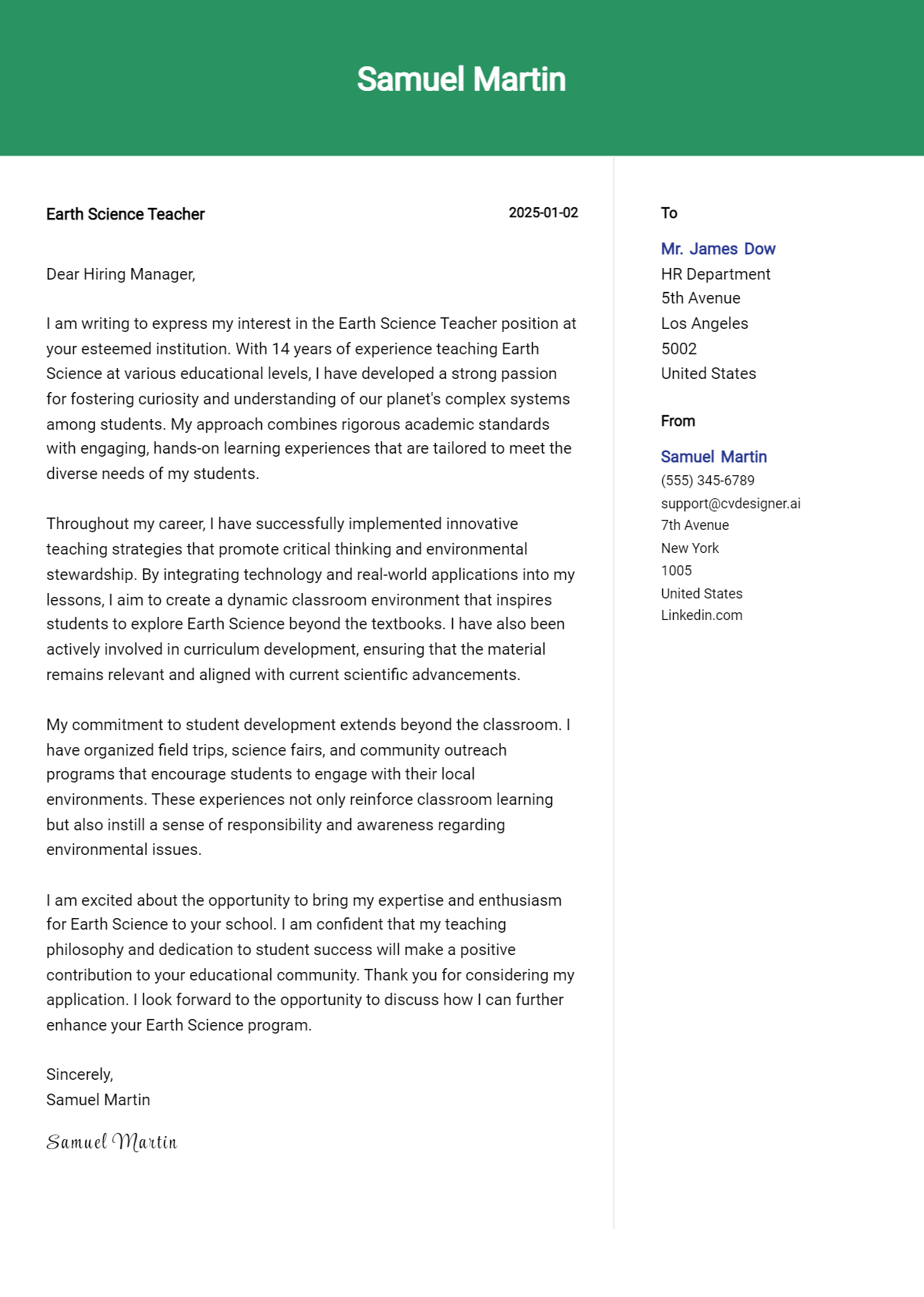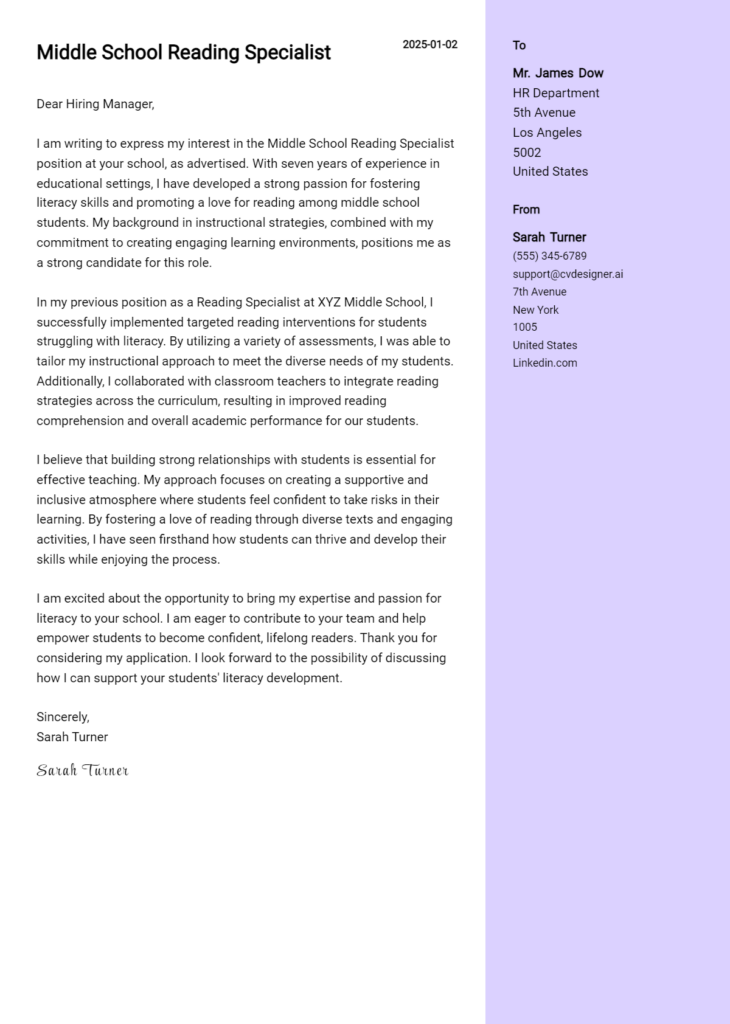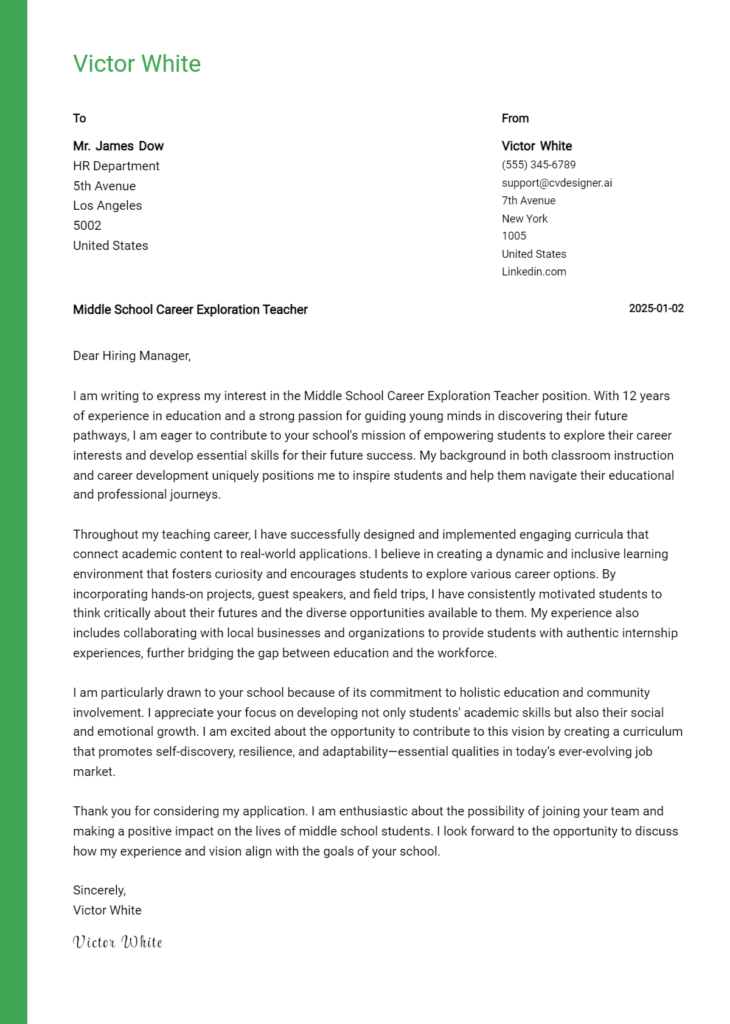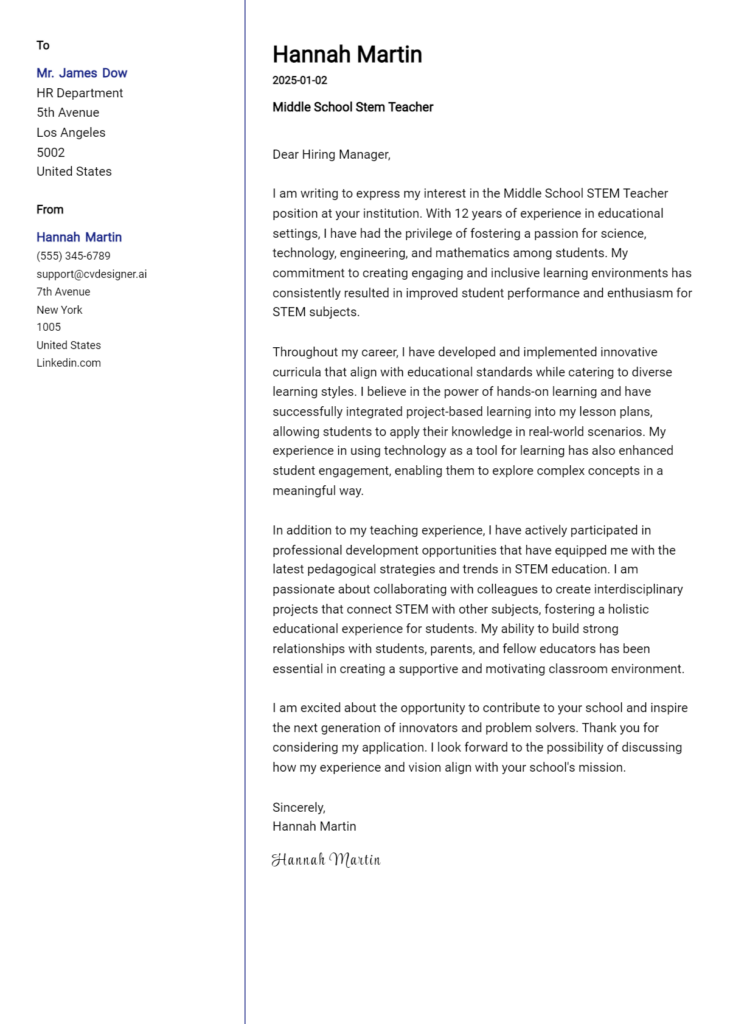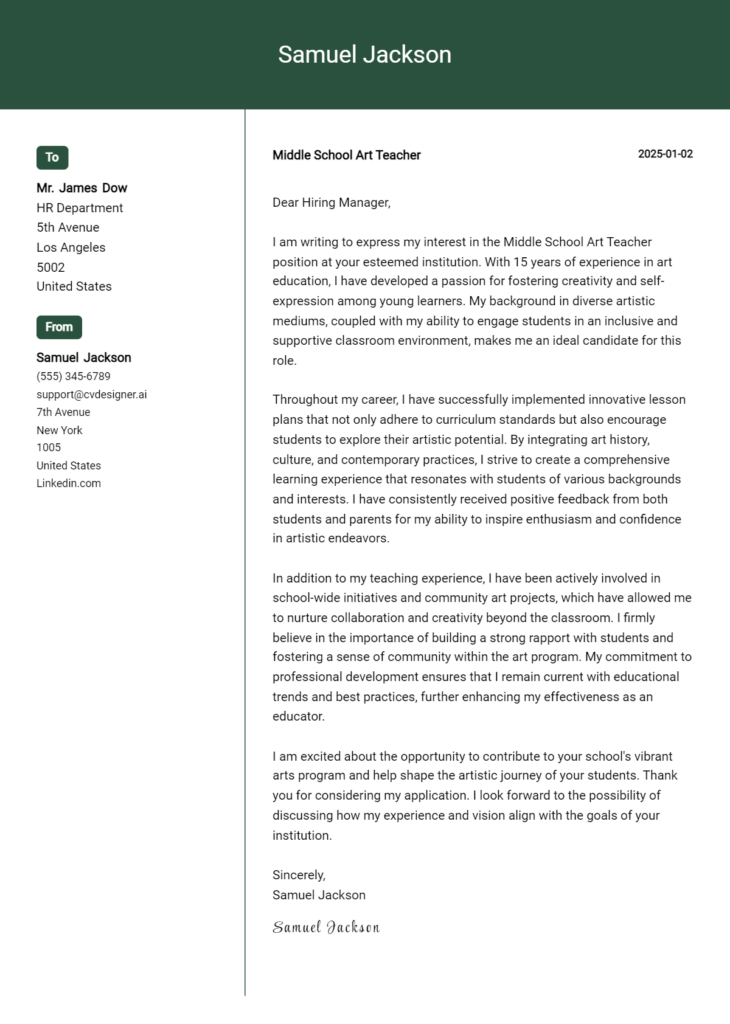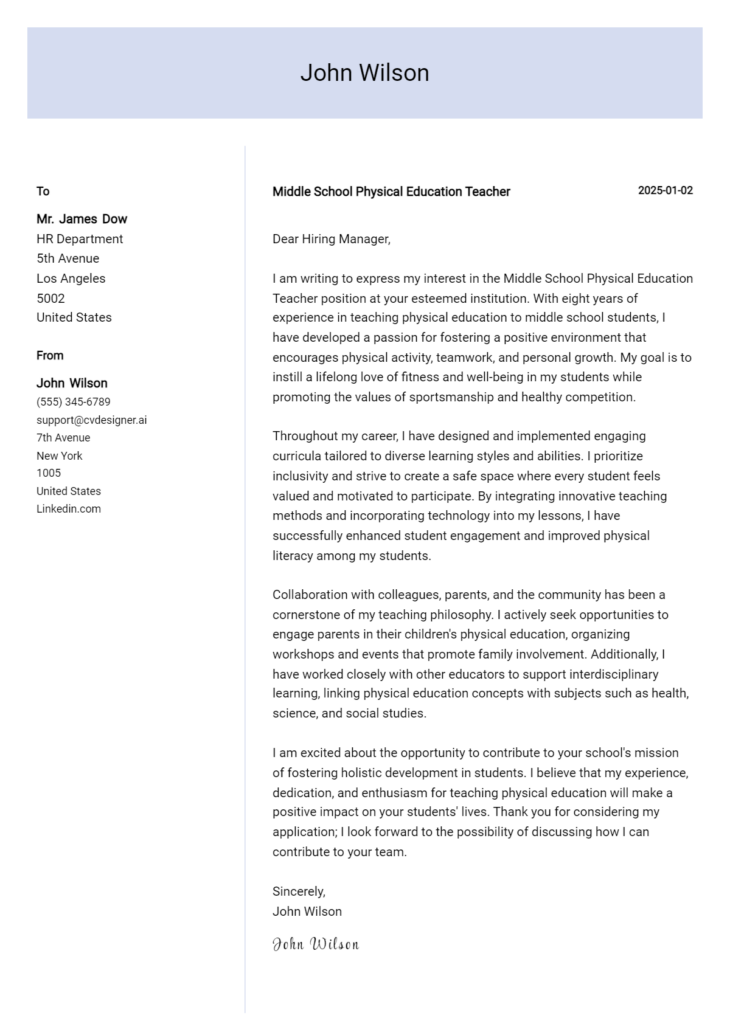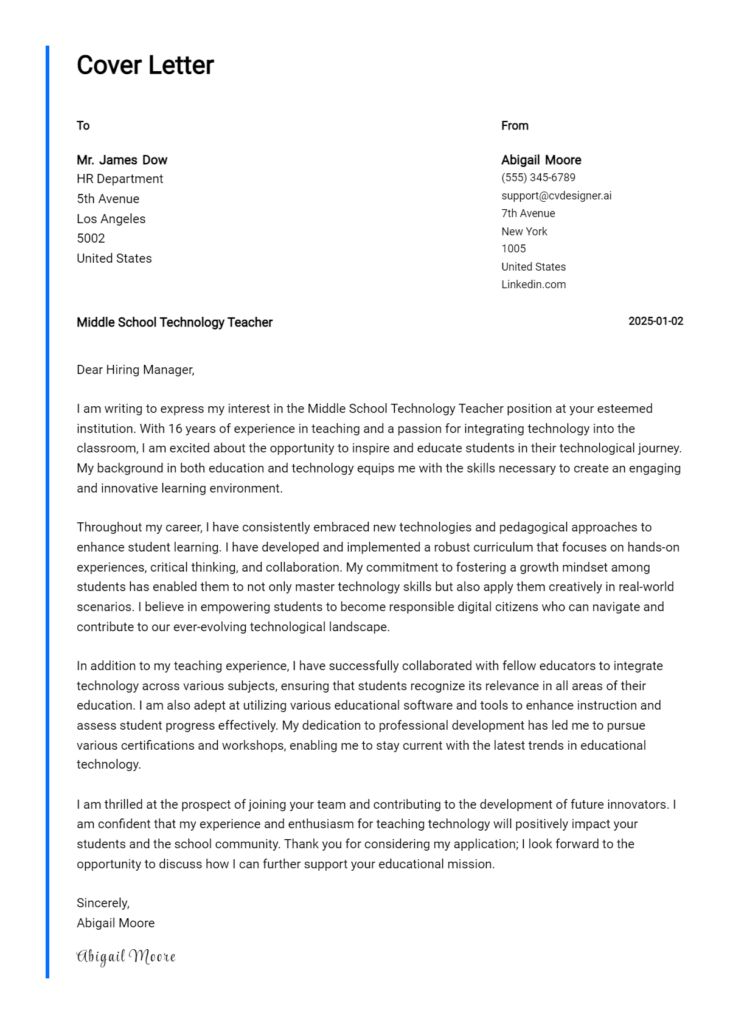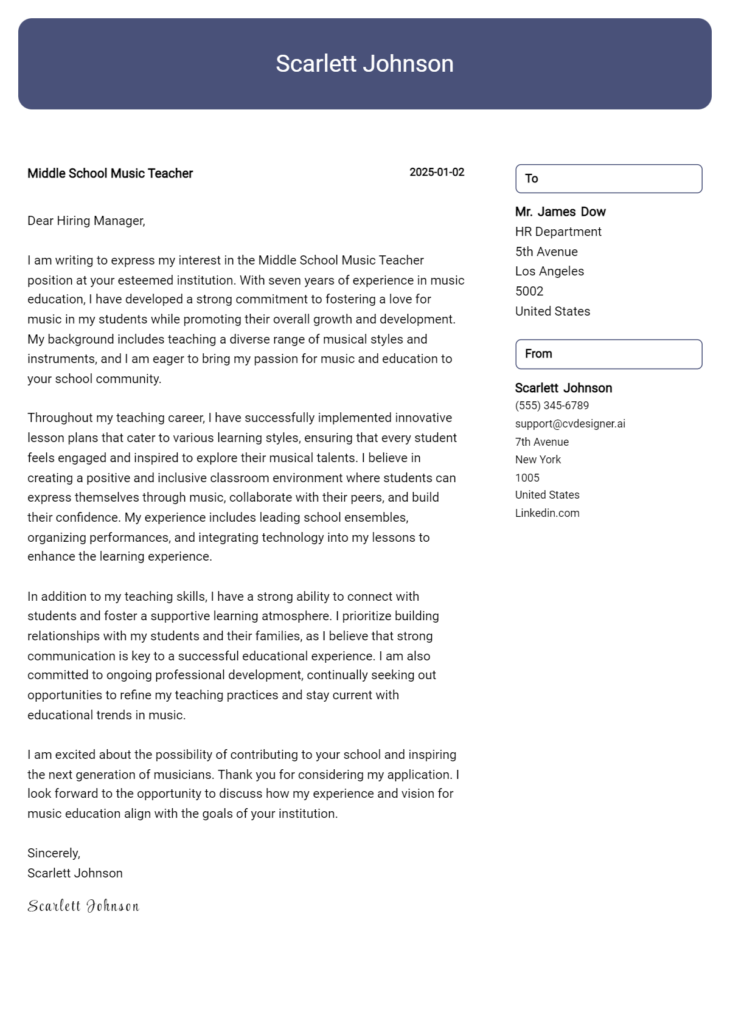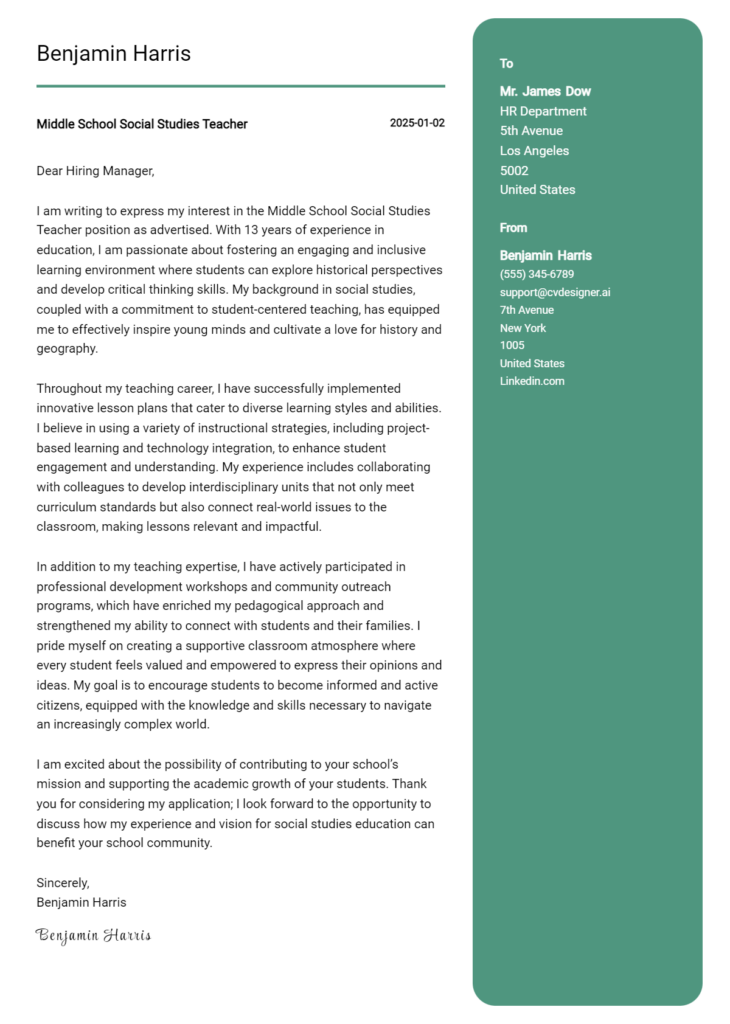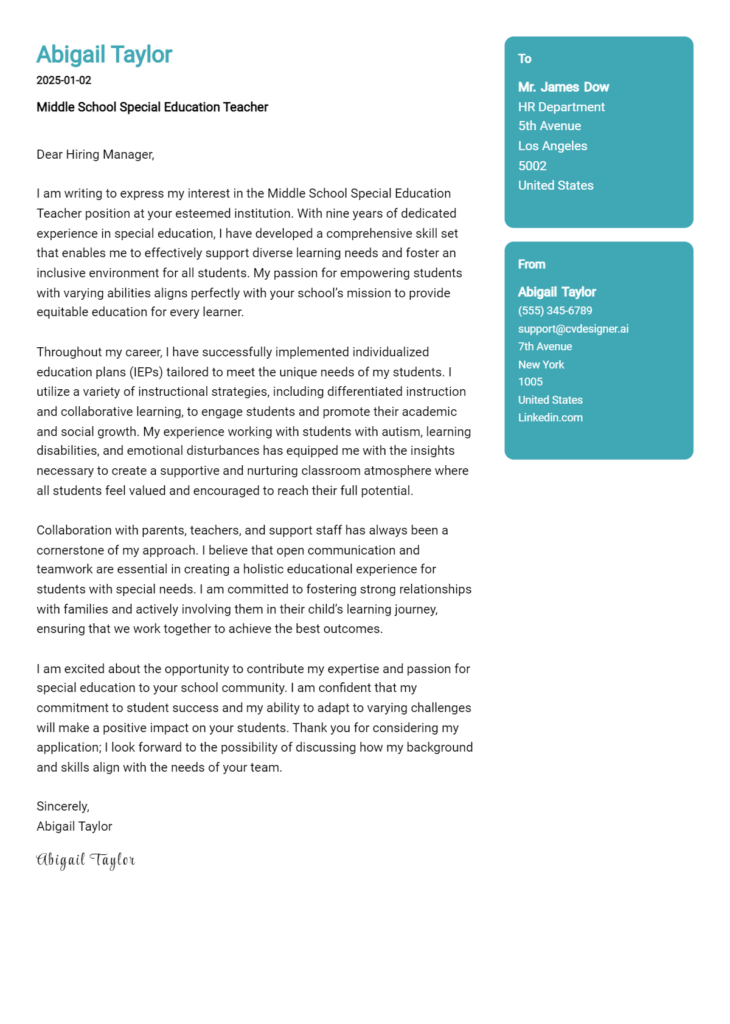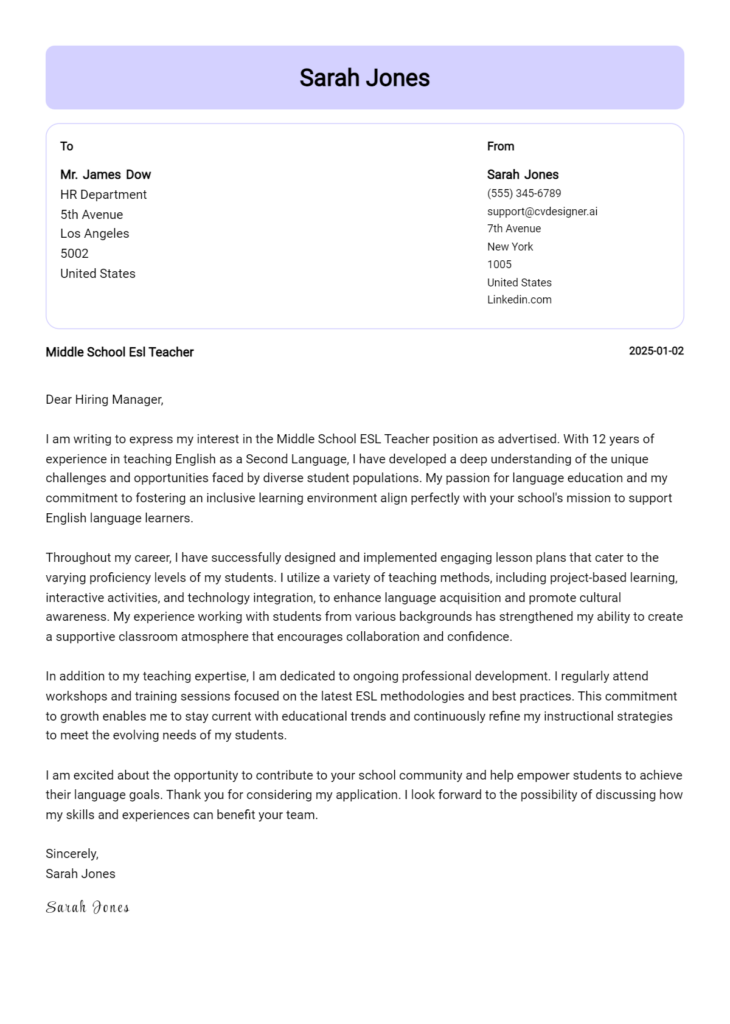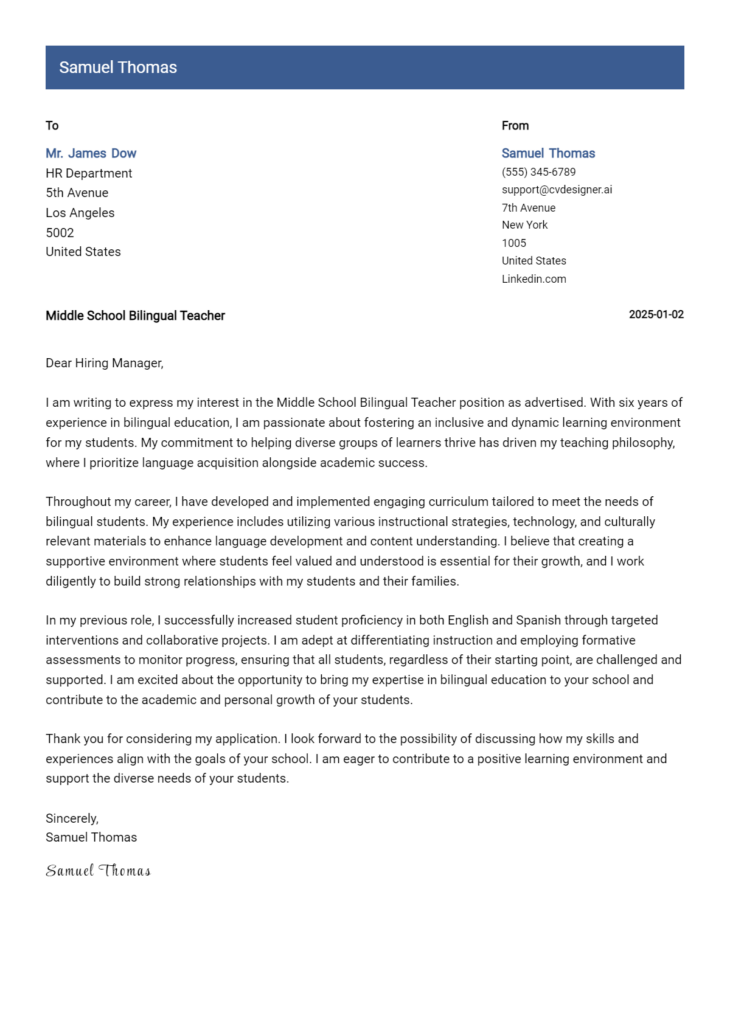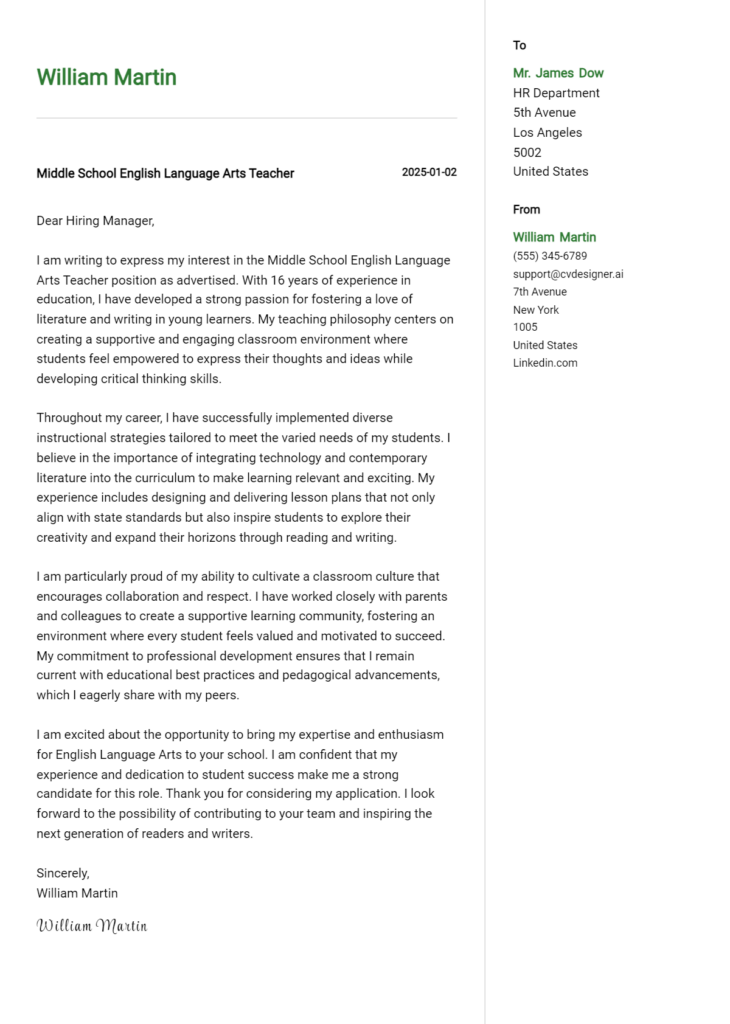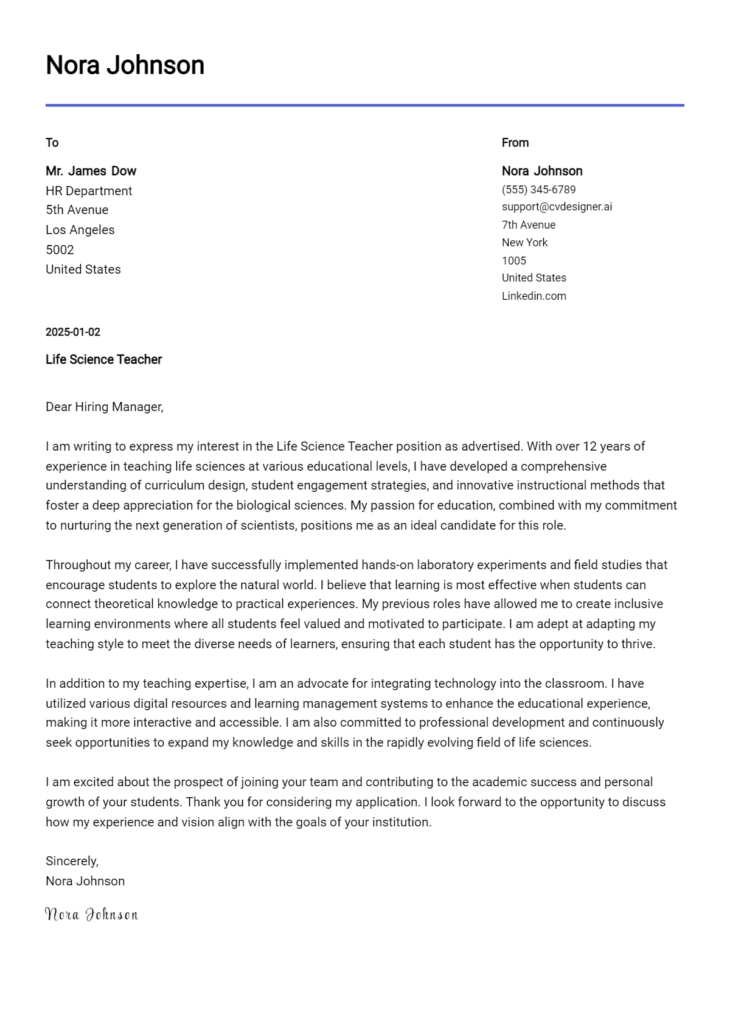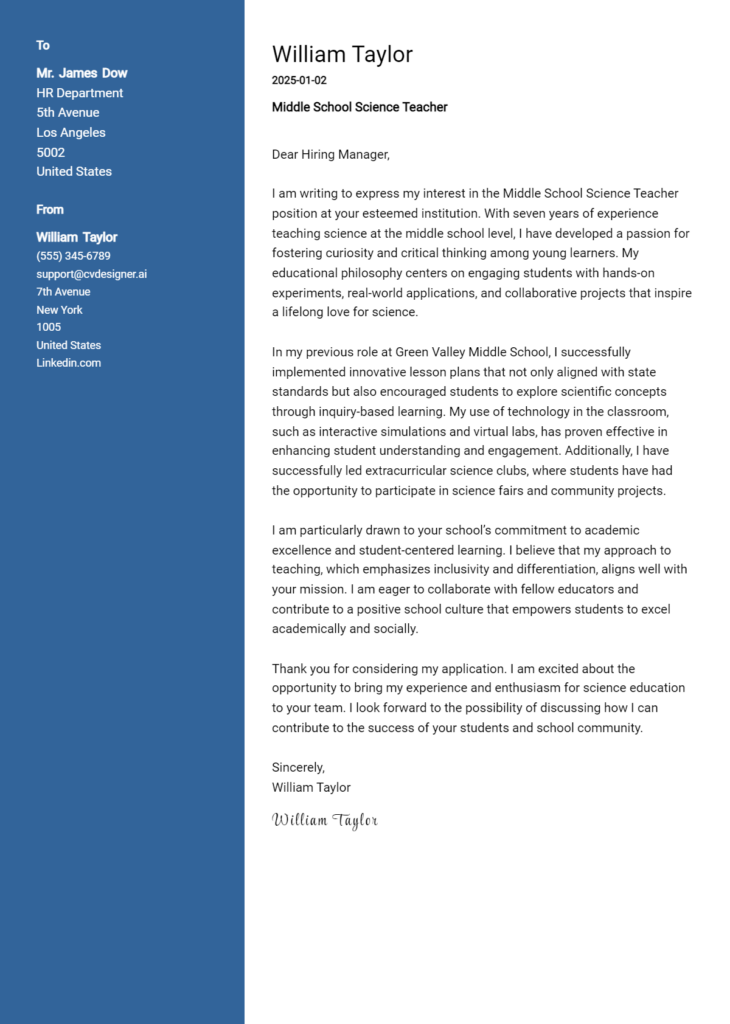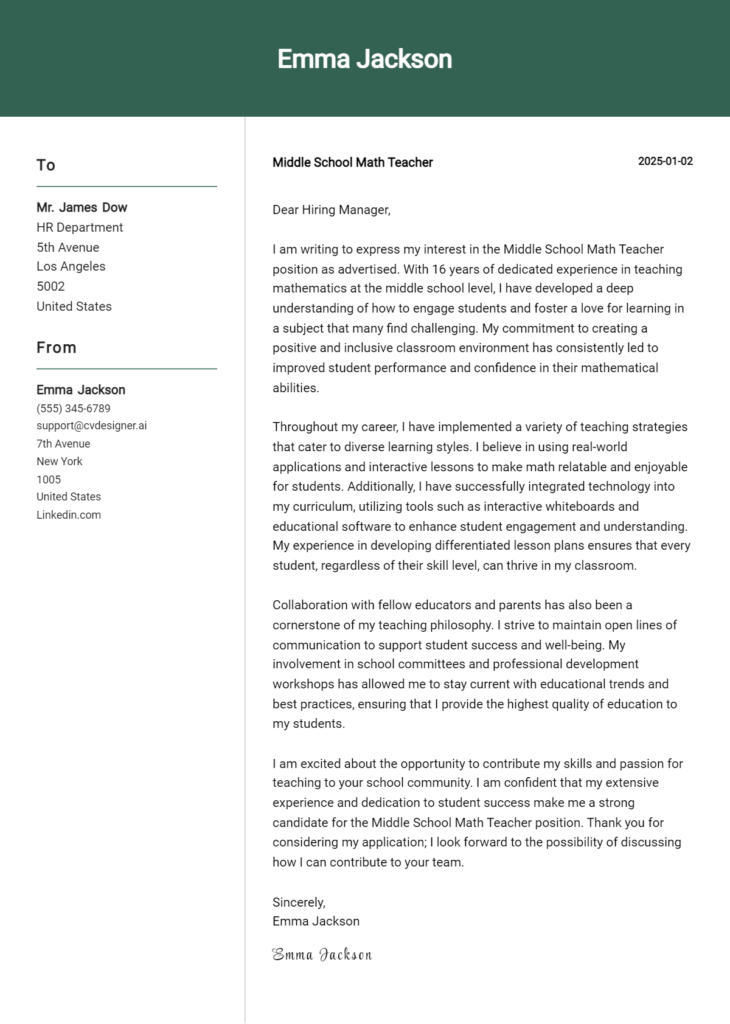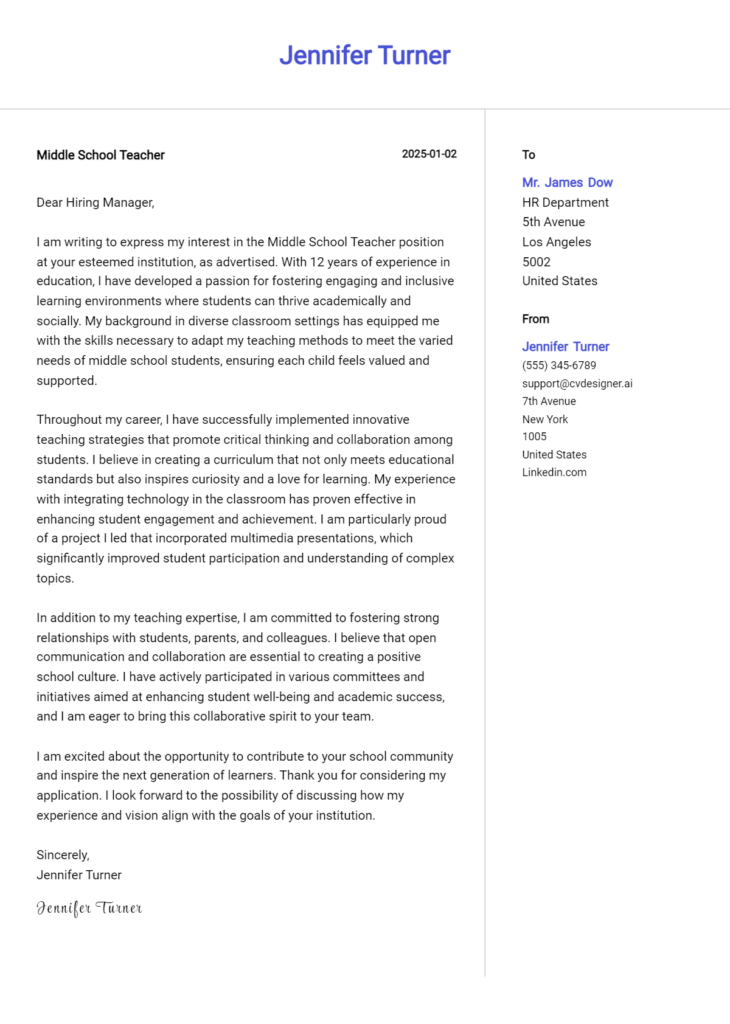Earth Science Teacher Cover Letter Examples
Explore additional Earth Science Teacher cover letter samples and guides and see what works for your level of experience or role.
How to Format an Earth Science Teacher Cover Letter?
Crafting a well-structured cover letter is essential for an Earth Science Teacher, as it serves as your first impression to potential employers. The format not only reflects your organizational skills but also demonstrates your commitment to education and attention to detail—qualities that are vital in teaching. A polished cover letter helps you effectively communicate your passion for Earth sciences and your ability to engage students in meaningful learning experiences.
In this guide, we'll explore how to construct your cover letter, offering insights and examples tailored specifically for Earth Science educators.
We'll cover the key components of a professional cover letter, including:
- Cover Letter Header
- Cover Letter Greeting
- Cover Letter Introduction
- Cover Letter Body
- Cover Letter Closing
Each section plays a crucial role in showcasing your qualifications and enthusiasm for teaching. Let’s delve into each part to help your Earth Science Teacher cover letter shine.
Importance of the Cover Letter Header for an Earth Science Teacher
A well-structured cover letter header is crucial for an Earth Science Teacher as it sets the tone for professionalism and clarity right from the start. The header should include your contact information, the date, and the recipient's details, ensuring that all parties can easily identify and reach you. A clear and organized header not only reflects your attention to detail but also enhances the readability of your application. A strong header can make a lasting impression, while a poorly formatted one may detract from the overall quality of your cover letter.
Here are examples of a strong and weak cover letter header for an Earth Science Teacher:
Strong Example
John Doe 123 Earth Lane Science City, ST 12345 johndoe@email.com (123) 456-7890 October 10, 2023 Ms. Jane Smith Principal Green Valley High School 456 Nature Rd Science Town, ST 67890
Weak Example
john d. 10/10/23 jane s.
The Importance of a Strong Cover Letter Greeting
The greeting of your cover letter is crucial in establishing an immediate connection with the hiring manager. It sets the tone for the entire letter, reflecting both your professionalism and your personal touch. A well-crafted greeting not only demonstrates respect but also shows that you have taken the time to research the organization and its staff. Personalizing your greeting by addressing the hiring manager directly can help you stand out in a competitive job market. Avoiding generic phrases like "To Whom It May Concern" is essential; instead, invest time in finding the recipient's name, which can often be found on the school’s website or through a quick phone call to the institution.
Here are examples of strong and weak greetings for an Earth Science Teacher cover letter:
Strong Greeting Example
Dear Dr. Smith,
Weak Greeting Example
To Whom It May Concern,
Importance of a Well-Crafted Cover Letter Introduction for an Earth Science Teacher
A compelling cover letter introduction is crucial for an Earth Science Teacher, as it serves as the first point of contact with the hiring manager. This section should grab attention, effectively communicating the candidate's enthusiasm for the position while also highlighting relevant skills and accomplishments. A strong introduction not only sets the tone for the rest of the letter but also makes a memorable impression that can differentiate the candidate from others. Below are examples of both strong and weak cover letter introductions for an Earth Science Teacher role.
Strong Example
Dear [Hiring Manager's Name], As a passionate Earth Science educator with over five years of experience in fostering a love for the natural world in my students, I am excited to apply for the Earth Science Teacher position at [School Name]. My commitment to hands-on learning and my expertise in integrating technology into the curriculum have resulted in significant improvements in student engagement and performance. I am eager to bring my innovative teaching methods and deep knowledge of environmental science to your distinguished school, inspiring the next generation of scientists.
Weak Example
To whom it may concern, I am writing to apply for the Earth Science Teacher job. I have taught Earth Science for a while and think I could do a good job. I like science and hope to get this position.
Purpose of the Cover Letter Body for an Earth Science Teacher
The body of a cover letter for an Earth Science Teacher serves as a critical component in showcasing the candidate's relevant skills, educational background, and teaching experiences that align with the needs of the educational institution. It allows the applicant to highlight specific projects or accomplishments that demonstrate their ability to engage students and foster a deep understanding of Earth science concepts. A compelling cover letter body not only reflects the candidate's passion for teaching but also emphasizes how their unique experiences can add value to the school's curriculum and contribute to the overall learning environment.
Strong Example
I am excited to apply for the Earth Science Teacher position at Green Valley High School, where I can bring my extensive experience and innovative teaching strategies to inspire students. During my tenure at Riverdale Middle School, I developed an interdisciplinary project called “Earth Explorers,” which combined hands-on geology fieldwork with data analysis in the classroom. This project not only improved student engagement by 30%, but it also fostered critical thinking skills as students examined real-world environmental issues. Additionally, I implemented interactive simulations that allowed students to visualize tectonic plate movements, resulting in a significant increase in test scores. I am eager to bring this passion for experiential learning and my commitment to academic excellence to your esteemed institution.
Weak Example
I want to apply for the Earth Science Teacher job. I have taught Earth science before and am familiar with the subject. I believe I can teach students well. I have done some projects, but they were not very memorable. I think I could help students learn, but I need to find out more about your school first.
Importance of the Cover Letter Closing for an Earth Science Teacher
The closing paragraph of a cover letter is crucial for leaving a lasting impression on hiring managers. It serves as a final opportunity to summarize your qualifications, reiterate your enthusiasm for the position, and encourage the next steps in the hiring process. A strong closing can highlight your passion for teaching Earth Science and your readiness to contribute to the educational community, while a weak closing may fail to convey your interest or leave the reader uncertain about your candidacy. Below are examples of both a strong and a weak cover letter closing for an Earth Science Teacher position.
Strong Example
Thank you for considering my application for the Earth Science Teacher position at [School Name]. With my background in environmental science and my passion for educating students about the Earth’s systems, I am excited about the opportunity to inspire the next generation. I look forward to the possibility of discussing how my skills and experiences align with the goals of your school. Please feel free to review my resume, and I hope to schedule an interview soon to further discuss my contributions to your team.
Weak Example
I hope you think about my application. I have some experience and I want to be a teacher. Let me know if you want to talk. Thanks for your time.
These tips will help candidates craft an effective cover letter for an Earth Science Teacher position. A well-written cover letter not only highlights your technical skills and problem-solving abilities but also showcases your knowledge of the scientific development life cycle (SDLC), your capacity for teamwork, and your passion for continuous learning. By emphasizing these qualities, you can make a strong impression on hiring committees.
Tips for Crafting an Effective Cover Letter
Highlight Your Technical Skills
Showcase your expertise in Earth science concepts, tools, and methodologies. Include specific examples of how you have applied these skills in the classroom, such as using GIS technology or conducting field studies. Don’t forget to mention any certifications or relevant coursework that strengthens your technical background.Demonstrate Problem-Solving Abilities
Share instances where you effectively addressed challenges in the classroom or during fieldwork. For example, discuss how you adapted your teaching strategies to accommodate different learning styles or resolved conflicts in group projects. This demonstrates your critical thinking and adaptability.Showcase Your Knowledge of SDLC
While SDLC is often associated with software development, it can also relate to scientific research and project management. Explain how you integrate the stages of SDLC in your lesson plans, such as planning experiments, gathering data, analysis, and presenting findings. This can illustrate your organizational skills and your approach to teaching scientific inquiry.Emphasize Teamwork and Collaboration
Earth science often involves collaborative projects, whether with students or colleagues. Describe your experiences working in teams, such as leading group projects or collaborating on curriculum development. Highlighting your ability to work well with others shows you are a team player, which is crucial in educational settings.Express a Passion for Continuous Learning
Education is an ever-evolving field, and your commitment to continuous learning is vital. Mention any professional development courses, workshops, or conferences you have attended related to Earth science. This not only shows your dedication to growing as an educator but also your eagerness to bring the latest knowledge and techniques into your classroom.
By utilizing these tips, you can create a compelling cover letter that effectively communicates your qualifications and enthusiasm for the Earth Science Teacher role. If you're looking for more resources, consider checking out various cover letter templates or using a cover letter builder to streamline your writing process.
Common Mistakes to Avoid in an Earth Science Teacher Cover Letter
Crafting an effective cover letter is essential for standing out in the competitive field of education, particularly for a specialized role like Earth Science Teacher. Avoiding common mistakes can significantly enhance your chances of making a positive impression. Here are some pitfalls to steer clear of:
Generic Greetings: Using "To Whom It May Concern" can give the impression of a lack of effort. Research the hiring manager's name and personalize your greeting.
Repetition of the Resume: Simply rehashing your resume in your cover letter doesn't add value. Instead, highlight specific experiences and skills relevant to teaching Earth Science.
Neglecting Key Qualifications: Failing to mention your relevant qualifications, such as certifications or specialized training, can weaken your application. Be sure to emphasize these areas.
Lack of Specific Examples: Vague statements about your teaching philosophy or experience come off as unconvincing. Use concrete examples to demonstrate your effectiveness as an educator.
Ignoring Cover Letter Format: A poorly formatted cover letter can be hard to read and may distract from your message. Follow a clear cover letter format to ensure clarity and professionalism.
Typos and Grammatical Errors: Spelling and grammatical mistakes can undermine your credibility. Proofread your letter thoroughly or consider using tools to help catch errors.
Failure to Show Passion: Failing to convey your enthusiasm for teaching Earth Science may make your application less compelling. Share what draws you to the subject and your teaching approach.
By avoiding these common mistakes, you can create a cover letter that effectively showcases your strengths and passion for teaching Earth Science. For additional guidance, you may find valuable insights in our cover letter examples.
Build your Cover Letter in minutes
Use an AI-powered cover letter builder and have your letter done in 5 minutes. Just select your template and our software will guide you through the process.

